ELECTRIC bicycles, or e-bikes as they're affectionately known, are not just bicycles with an identity crisis, nor are they motorcycles going through a minimalist phase. Instead, they represent the perfect marriage between traditional pedal power and the wonders of electric propulsion.

In this blog, we'll dive deep into the world of e-bikes, shedding light on everything from their eco-friendly charm and the surprising health benefits to the nitty-gritty of their inner workings. We'll guide you through the different types of e-bikes to help you find your electric soulmate and explain the pivotal components that make these two-wheeled wonders tick.
So, buckle up-or rather, strap on your helmet-as we set foot on this electrifying journey through the past, present, and future of e-bikes. Whether you're a seasoned cyclist or new to the concept, prepare to be enlightened, entertained, and perhaps even a little bit electrified.
- Advantages of E-bikes
- License-Free Cycling
- Reduced Strain
- Extended Distance and Enhanced Enjoyment
- Eco-Friendly Commuting
- Smart Cycling
- Types of Ebikes
- Components of Electric Bicycles
- Ebike Frame
- Frame Structure
- Frame Geometry
- How to Choose the Right E-bike Geometry
- Common Frame Materials
- How to Choose the right e-bike material
- Frame Size
- How to choose the right e-bike frame size?
- Fork
- Transmission System
- Drivetrain
- Wheelset System
- Components of the Wheelset System
- Wheel Sizes
- How to Choose the Right E-bike Wheel Size
- Ebike Tire Size
- Brake System
- Control System
- Tri-Electric System
- The Bottom Line
Advantages of E-bikes
E-bikes have a lot to offer:
License-Free Cycling
E-bikes offer the unique advantage of preserving the essence of traditional cycling while integrating electric power assistance. This fusion means riders can enjoy cycling without the added complexity of obtaining a license, as is often required for motor vehicles. The electric assistance kicks in to provide a boost, especially during uphill climbs or long distances, making cycling accessible and enjoyable without diluting its core experience.
Reduced Strain
The design of e-bikes incorporates electric motors to assist the rider's pedal power. This assistance can be crucial for individuals who may experience joint pain or fatigue from traditional cycling. By reducing the effort required to pedal, e-bikes minimize the stress on knees, hips, and other parts of the body, making cycling a viable and enjoyable form of exercise for a broader demographic, including older adults or those rehabilitating from injuries.
Extended Distance and Enhanced Enjoyment
With the added power assistance, e-bikes significantly increase the range one can cover compared to traditional bicycles. This capability enables riders to explore farther and wider without worrying about excessive physical exertion. Consequently, cyclists can discover and appreciate more diverse landscapes and sceneries, enriching the overall outdoor experience. The ability to cover more ground effortlessly also opens up new possibilities for cycling tours and adventures.
Eco-Friendly Commuting
E-bikes provide a practical solution for daily commuting, allowing individuals to arrive at their destinations without the sweat and fatigue associated with traditional biking or the congestion and emissions related to car travel. They offer an eco-friendly alternative to fossil fuel-dependent vehicles, reducing carbon footprint and urban noise pollution. As cities worldwide strive for sustainability, e-bikes represent a step forward in achieving greener urban environments without sacrificing personal mobility.
Smart Cycling
The integration of advanced technology into e-bikes positions them at the forefront of the Internet of Things (IoT) movement. Modern e-bikes come equipped with features such as GPS tracking, performance monitoring, and even smart locking mechanisms, all accessible through smartphone applications. These technological advancements not only enhance the user experience by providing valuable data and security but also pave the way for innovative uses in urban planning, shared mobility services, and personal fitness tracking. The evolution of e-bikes into smart, connected devices exemplifies the potential for technology to revolutionize personal transportation.
By leveraging these advantages, e-bikes stand out as a versatile, inclusive, and forward-thinking mode of transportation that aligns with contemporary needs and technological advancements.
Types of Ebikes
E-bikes can be categorized based on power assistance, motor power, design style, and intended use:
By Type of Power Assistance
- Pedelecs (Pedal Assist):Pedelec stands for "Pedal Electric Cycle." These e-bikes amplify the rider's pedaling effort with a motor. They do not offer a throttle and require pedaling to activate the motor. The assistance automatically adjusts based on pedaling force, making for a more intuitive and natural cycling experience. They are widely accepted in many countries due to their safety and similarity to traditional bikes.
- Throttle-on-Demand:These e-bikes can be propelled without pedaling, thanks to a throttle on the handlebar, similar to motorcycle controls. They offer the option to pedal with or without assistance or to ride solely on electric power. This type is especially useful for those who may need a break from pedaling due to fatigue or for navigating through traffic with ease.
By Motor Power
- Low-Power E-bikes:Typically equipped with motors of 250 watts or less, these e-bikes are designed for basic commuting and recreational use. They offer sufficient power for flat terrains and modest hills, making them ideal for urban environments and riders seeking a gentle assist.
- High-Power E-bikes:With motors exceeding 250 watts, high-power e-bikes provide substantial assistance and are capable of higher speeds and tackling steep inclines. They cater to those seeking more thrill, off-road adventures, or needing to cover long distances quickly.
By Utility
- Longtail Bikes:These e-bikes have an extended rear over the back wheel to provide extra space for cargo or additional seating for passengers. They often come with built-in racks or platforms and are popular for their balance and handling.
- Front Loaders (Bakfiets):These bikes feature a large box or cargo area at the front, between the handlebars and the front wheel. This design allows for substantial cargo capacity and can often accommodate seating for children or pets, providing a direct view for the rider.
- Mid-tail Bikes:A compact version of the longtail, mid-tail bikes offer a shorter extended rear end. These are easier to store and maneuver while still providing extra cargo space compared to a standard e-bike.
By Design Style
- Urban/Commuter E-bikes:Tailored for daily commuting and city riding, these e-bikes often feature comfortable seating positions, storage options, and lights. They are designed for efficiency and convenience in urban landscapes.
- Mountain E-bikes (E-MTB):Engineered for off-road conditions, e-MTBs come with robust frames, suspension systems, and tires suited for rough terrains. They provide the power needed to climb steep trails and the durability to withstand challenging conditions.
- Road E-bikes:These are streamlined for speed and performance on paved roads. They typically have a lightweight design and positioning that encourages an aerodynamic posture, mirroring traditional road bicycles but with the added benefit of electric assistance.
- Folding E-bikes:Known for their portability, folding e-bikes can be easily transported and stored in compact spaces. Ideal for commuters who may need to take their bike on public transportation or store it in an office, they combine convenience with the benefits of electric assistance.
By Intended Use
- Recreational Riding E-bikes:Designed for casual use, such as weekend rides through the park or short commutes. They often emphasize comfort and ease of use over performance or specialized features.
- Sport E-bikes:Aimed at riders looking for enhanced performance for fitness, racing, or off-road adventures. These bikes are equipped with features that support intense activities, including powerful motors, advanced suspension systems, and durable components.
- Commercial E-bike:Customized for business applications, including delivery services or rentals. They may come with cargo storage capabilities, enhanced durability for frequent use, and features tailored to specific commercial needs.
Understanding these categories aids in navigating the diverse e-bike market, ensuring consumers can find an e-bike that aligns with their lifestyle, preferences, and requirements.
Components of Electric Bicycles

Ebike Frame
The frame not only supports the weight of the rider but also anchors all critical components of the e-bike, including the motor, battery, and drivetrain, shaping the bike's performance characteristics and ergonomic comfort. It is instrumental in determining the overall ride quality, influencing factors such as stability, handling, and efficiency of power transfer from the rider to the wheels. A step closer, let's look at the structure and common materials used in e-bike frames:
Frame Structure
The key elements of the frame include:
- Bottom Bracket:This crucial pivot point in the frame's lower region not only supports the rider's pedaling force but also serves as a critical junction where mechanical energy is transferred to the drivetrain. Its design and placement significantly affect the bike's ground clearance and pedaling dynamics.
- Down Tube: Often the largest tube in the frame, the down tube plays a significant role in defining the frame's rigidity and handling characteristics. Its capacity to house the e-bike's battery not only centralizes weight distribution for improved balance but also protects the battery from environmental elements and impacts.
- Top Tube:This element is key to the frame's structural integrity, contributing to the distribution of rider weight and providing lateral stiffness. Its length and angle are decisive in setting the rider's posture, affecting aerodynamics and comfort during long rides.
- Seat Tube:The orientation and length of the seat tube influence the bike's seating position and pedal efficiency, directly impacting rider ergonomics. Its design accommodates the seat post, allowing for adjustments in ride height and style.
- Seat Stay & Chain Stay:These rear frame components absorb road vibrations and distribute stress, enhancing ride comfort and traction. Their design impacts the bike's responsiveness and stability, especially during acceleration and climbing.
- Dropout:Engineered to securely anchor the wheel hubs, the dropout's design ensures precise alignment of the wheels, essential for safe and efficient power transfer, braking, and gear shifting.
- Head Tube:The head tube's angle and length are critical for steering precision and front-end stability, affecting the bike's agility and handling in various riding conditions. It also supports the fork and headset, integrating the steering mechanism.
- Derailleur Hanger:This replaceable component not only facilitates smooth gear shifting by holding the derailleur in the optimal position but also protects the frame and drivetrain from damage during falls or collisions by acting as a breakaway part.
To summarize, the e-bike frame is a masterpiece of engineering that harmonizes strength, flexibility, and precision to enhance the electric biking experience.
Frame Geometry
Frame geometry is a crucial consideration in the design of electric bicycles, as it determines the bike's handling, comfort, and adaptability to different riding conditions. The design of the frame affects the riding posture, thereby influencing power transmission and the level of fatigue experienced by the rider. Different types of electric bicycles have specific frame geometries designed to suit particular usage scenarios and riding styles:
- Comfort E-bikes:These bikes typically feature a more upright frame design to enhance riding comfort and ease of use. An upright posture helps reduce pressure on the back and shoulders, making long rides more comfortable.
- Active E-bikes:Active e-bike frame geometries focus on speed and flexibility. These designs usually include lower handlebars and longer frames to promote a more aggressive riding posture, thereby improving speed and responsiveness.
- Performance/Racing E-bikes:The frame geometry of racing e-bikes is the most aggressive, often featuring even lower handlebars and more compact frame geometry. This design helps reduce air resistance during high-speed riding, increasing efficiency and speed.
Understanding and choosing the right frame geometry is crucial for achieving the best riding experience.
How to Choose the Right E-bike Geometry
To choose the appropriate frame geometry for your e-bike, you can follow these key steps for a comfortable, efficient, and safe riding experience:
- Define Your Riding Purpose: Are you commuting daily, enjoying leisure rides, or seeking performance in racing?
- Consider the Riding Environment: Will you primarily ride on urban roads, mountain trails, or mixed terrains?
- Adjust Budget and Preferences: Consider your budget and personal preferences for comfort and performance.
- Test Different Frames: If possible, test ride bikes with different frame geometries to find the one that suits you best.
- Professional Advice: Seek advice from a professional bike shop or a cycling coach who can provide personalized recommendations based on your physical characteristics and riding habits.
By following these steps, you can select the most suitable electric bicycle, whether you are seeking comfort in leisure rides or performance in racing challenges.
Common Frame Materials
- Aluminum Alloy:Widely used due to its light weight, corrosion resistance, and affordability. Aluminum frames are known for their stiffness, providing a responsive ride, though they can be less forgiving on bumpy surfaces compared to more flexible materials.
- Carbon Fiber:Offers the best strength-to-weight ratio, making it ideal for high-performance e-bikes. Carbon fiber frames deliver excellent vibration damping, leading to a smoother ride. However, they are more expensive and require careful handling to avoid damage.
- Steel:Steel frames are valued for their strength, durability, and cost-effectiveness. They are heavier than aluminum but provide a very comfortable ride due to their ability to absorb vibrations. Steel is also highly repairable, making it a practical choice for those who prioritize longevity and ease of maintenance over lightness.
- Stainless Steel:Known for its durability and corrosion resistance, stainless steel frames offer a good balance of strength and flexibility, leading to a comfortable ride. They tend to be heavier than aluminum and carbon fiber frames and are less common in modern e-bikes.
- Titanium Alloy:Combines the best qualities of other materials, offering lightweight, strength, and corrosion resistance. Titanium frames are highly durable and provide a smooth ride with natural flex. However, they are among the most expensive due to the complexity of working with titanium.
How to Choose the right e-bike material
Well, consider your main riding goals, the typical conditions you'll face, and your budget. If you're looking for high performance and are willing to invest in the most advanced technology, carbon fiber might be the best choice. For those seeking durability and a balance of performance and affordability, aluminum is a popular and versatile option. If you prefer the timeless appeal and resilience of metal with a budget for premium materials, consider stainless steel or titanium. For riders who prioritize comfort, durability, and cost-effectiveness and are less concerned with weight, steel is an excellent choice.
Frame Size
The frame size of an e-bike plays a crucial role in determining the rider's comfort, control, and efficiency while cycling. It directly impacts the rider's ability to maintain a proper riding posture, which is essential for minimizing strain and fatigue, especially during longer rides.
A correctly sized frame ensures that the rider can easily reach the ground with their feet when stopped, reach the handlebars without overextending, and pedal efficiently without being too cramped or stretched out. This is particularly important for e-bikes, as their added weight and power assistance can amplify the effects of a poor fit, potentially affecting the bike's handling and the rider's ability to control it effectively.
Therefore, choosing the right frame size is fundamental to maximizing the benefits of e-bike technology, enhancing the riding experience by ensuring safety, comfort, and optimal performance across various terrains and riding conditions.
How to choose the right e-bike frame size?
Well, you may take the key steps:
To select the right frame size for your e-bike, follow these key steps for a comfortable, efficient, and safe riding experience:
- Measure Height and Inseam:Determine your height and inseam length to establish a baseline for the frame size. The inseam is vital for ensuring you can comfortably stand over the bike.
- Use Manufacturer's Size Chart:Consult size charts from e-bike manufacturers, using your measurements as a guide. Remember, variations in body proportions mean charts may not be universally accurate.
- Consider Ebike Types:
- Mountain E-bikes: Generally, mountain bikes require more clearance between the bike and the rider for better maneuverability over rough terrain. This might mean choosing a slightly smaller frame than suggested by your height alone.
- Road E-bikes: Road bikes tend to have a more stretched-out riding position. Frame size is crucial to ensure the rider can maintain this position comfortably for extended periods.
- Hybrid and City E-bikes: These bikes are designed for comfort, so ensuring there is enough standover height to get on and off the bike easily is essential.
- Test Ride:Always test different frame sizes to find the best fit, focusing on ease of reaching handlebars and pedals and maintaining posture.
- Check Adjustability:Some bike elements can be adjusted (seat height, handlebar position), but the frame size is fixed. It's critical to get it right from the outset.
- Expert Consultation:When in doubt, seek advice from a bike fitting expert or a knowledgeable bike shop salesperson to find a tailored fit based on your measurements and preferences.
You can also check out the e-bike frame size chart:
|
Rider's Height (in) |
Inseam (in) |
Mountain E-bike Frame Size (in) |
Road E-bike Frame Size (cm) |
Hybrid/City E-bike Frame Size (in) |
|
4'10" - 5'2" |
26" - 28" |
13" - 14" |
47 - 49 |
14" - 15" |
|
5'2" - 5'6" |
28" - 30" |
15" - 16" |
49 - 52 |
15" - 16" |
|
5'6" - 5'10" |
30" - 32" |
17" - 18" |
52 - 55 |
17" - 18" |
|
5'10" - 6'1" |
32" - 34" |
19" - 20" |
55 - 58 |
19" - 20" |
|
6'1" - 6'4" |
34" - 36" |
21" - 22" |
58 - 61 |
21" - 22" |
|
6'4" and up |
36" and up |
23" - 24" |
61 - 63 |
23" - 24" |
Fork
The fork of an electric bicycle matters in the bike's steering and ride quality. It connects the front wheel and handlebars to the frame, allowing the rider to steer and control the bike. Forks are categorized into two main types: rigid forks and suspension forks, each offering distinct advantages and contributing differently to the riding experience.

Rigid Forks
Rigid forks are made from a single piece of material without any moving parts. They are known for their simplicity and durability. Here are some key characteristics and benefits:
- Lightweight and Efficient: Rigid forks are lighter than their suspension counterparts, making them ideal for bikes where weight savings are crucial, such as road or racing bikes.
- Direct Handling:They provide precise steering response, which is highly valued in competitive cycling and on smooth surfaces.
- Low Maintenance:Without any suspension elements, rigid forks require less maintenance, making them a practical choice for urban commuters and casual riders.
Suspension Forks
Suspension forks incorporate springs, air, or elastomers to absorb shocks from uneven terrain, significantly improving comfort and control in rough conditions. Characteristics include:
- Shock Absorption:By absorbing bumps and vibrations, suspension forks provide a smoother ride on uneven terrains, reducing rider fatigue and enhancing control.
- Adjustable Performance:Many suspension forks offer adjustments for preload, rebound, and sometimes even lockout capabilities, allowing riders to tailor the fork's performance to specific trail conditions or personal preferences.
- Increased Weight:The added complexity of suspension systems results in a heavier fork, which can affect the bike's overall weight and efficiency.
Fork Trail Value
The fork trail is a crucial geometric parameter that impacts an E-bike's handling characteristics. It is defined as the distance between the line extending through the steering axis (imagined from the head tube through the fork) and the point on the ground where the front wheel's axis touches. Fork trail values can vary significantly depending on the bike's intended use and design philosophy. For instance:
- Road E-bikes: Typically, road e-bikes have a fork trail between 55mm and 65mm, designed to balance high-speed stability with the agility needed for cornering and maneuvering in pelotons. Road bikes usually employ rigid forks due to their efficiency and lighter weight.
- Mountain E-bikes: These bikes may have a broader fork trail range, generally between 80mm to 150mm, to ensure stability over rough terrain at higher speeds while still allowing responsive control when navigating technical sections. The greater fork trail helps manage the dynamic forces encountered on varied mountain trails.
- City E-bikes: Usually feature a fork trail on the lower end, around 40mm to 80mm, to enhance maneuverability in urban environments where frequent and quick direction changes are common. This range helps with agile handling through busy city streets.
Here's how fork trail impacts riding:
- Stability vs. Maneuverability:A larger fork trail value generally results in more stable steering at high speeds but can make the bike feel less responsive at lower speeds. Conversely, a smaller fork trail value enhances low-speed maneuverability at the expense of high-speed stability.
- Influence on Riding Experience:The fork trail affects how a bike "feels" to the rider. Bikes designed for fast, aggressive riding or heavy loads often feature a longer trail for stability, while those designed for agility, such as city bikes, might have a shorter trail.
Understanding the type of fork and the fork trail value is essential when selecting or designing an e-bike, as these components significantly affect the bike's handling, comfort, and overall performance in different riding conditions.
Transmission System
The transmission system of an electric assist bicycle, often referred to as the drivetrain, plays a vital role in managing the bike's speed, efficiency, and handling. It encompasses several components, each contributing to the seamless transfer of power from the rider to the wheels. Key elements include the front and rear derailleurs, shifters, chain, crankset, cassette, and in some cases, an integrated motor. Understanding these components provides insight into how e-bikes transform pedal power into motion.

Front and Rear Derailleurs
- Front Derailleur:The front derailleur moves the chain between different chain rings on the crankset, allowing for coarse adjustments in gear ratio. This component is pivotal in creating a broad range of gears for tackling various terrains, from steep climbs to fast flats.
- Rear Derailleur:The rear derailleur facilitates the movement of the chain across the cassette's different sprockets at the rear wheel, offering fine-tuning of the bike's gearing. It is crucial for smooth, precise gear changes and maintains chain tension.
Shifters
Shifters are the rider's interface for controlling the derailleurs, hence, the gear selection. There are various types of shifters:
- Trigger Shifters:Common on mountain and road bikes, these allow for gear changes through a push or pull of a lever with the thumb and index finger.
- Twist Shifters:Integrated into the handlebar grips, these shift gears when the rider twists a section of the grip. They are often found on recreational or entry-level bikes for their simplicity.
- Electronic Shifters:Utilizing electronic signals to change gears, these offer precise and swift gear changes with minimal effort. They're typically seen on high-end e-bikes and performance bicycles.
Chain, Crankset, and Cassette
- Chain:The chain transfers the pedaling force to the rear wheel. Its durability and smooth operation are essential for efficient biking.
- Crankset:This component converts the reciprocating motion of the rider's legs into rotational motion needed to drive the chain and propel the bike forward. It consists of one or more chain rings.
- Cassette:Attached to the rear wheel's hub, the cassette is a set of sprockets offering various gear ratios. The number of gears in a cassette can vary, influencing the bike's gearing range and its adaptability to different slopes and speeds.
In e-bikes, the transmission system often works in tandem with an electric motor, enhancing the rider's pedaling force. This integration allows for smoother acceleration, reduced physical strain, and the ability to maintain higher speeds with less effort. The motor's assistance level can usually be adjusted via a control on the handlebars, allowing riders to customize their level of effort and the battery's usage.
Overall, the transmission system's efficiency and responsiveness play a significant role in the e-bike's performance, affecting its speed, agility, and comfort. High-quality components and proper maintenance are key to ensuring a seamless and enjoyable riding experience.
Drivetrain
The drivetrain of an electric assist bicycle is a critical component that facilitates the transfer of power from the rider to the road, enabling the bicycle to move forward. It encompasses several interconnected parts, such as Chainring and Bottom Bracket (BB) Axle, Derailleurs, etc., each of which play a specific role in the bike's overall performance and efficiency. Understanding these components helps in appreciating how an e-bike converts human effort into mobility, providing a seamless cycling experience across various terrains and conditions.
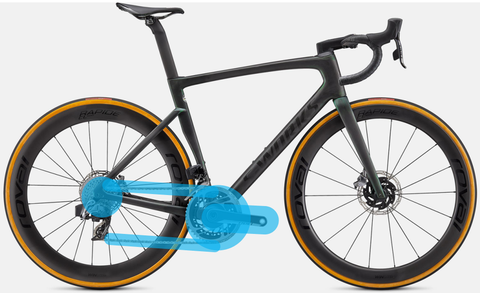
Functionality and Performance
The drivetrain's design directly impacts the e-bike's performance, influencing its speed, agility, and ability to tackle various terrains. Key performance factors include:
- Gear Ratio:The combination of chainring size and cassette sprocket selection dictates the gear ratio, affecting how hard the rider has to pedal to maintain a certain speed. A lower gear ratio eases pedaling at slower speeds or uphill, while a higher gear ratio is more efficient on flat or downhill segments.
- Efficiency:The drivetrain's efficiency is influenced by the quality and condition of its components. Regular maintenance, such as cleaning the chain and ensuring proper lubrication, is crucial to minimize energy loss through friction and wear.
- Compatibility with Electric Assist:In e-bikes, the drivetrain works in conjunction with the electric motor, enhancing the rider's pedaling force. This synergy allows for smoother starts, easier hill climbs, and reduced rider fatigue, making cycling more accessible and enjoyable for a broader range of people.
Overall, the drivetrain is a testament to the intricate engineering behind e-bikes, showcasing how mechanical and electrical components can work together to revolutionize personal transportation. Its optimization and maintenance are key to ensuring the best possible riding experience.
NOTE: The transmission system and drivetrain in electric bikes play closely intertwined and complementary roles. The transmission system, as a mechanism for adjusting speed and torque, is a critical component of the drivetrain, focusing on adapting to varying riding conditions by changing gear ratios. It allows riders to shift gears to maintain efficiency across different terrains, such as uphill, downhill, or flat surfaces. Meanwhile, the drivetrain encompasses all components involved in transferring the rider's pedaling force to the bike's wheels, including gears, chains, pedals, cranksets, and the rear wheel's cassette. In essence, while the transmission system fine-tunes the bike's performance through gear adjustments, the drivetrain is the comprehensive system that delivers power from the rider to the road, facilitating motion.
Wheelset System
The wheelset system is a fundamental component of electric assist bicycles, encompassing the wheels themselves (including rims and hubs), tires, and tubes. This system plays a pivotal role in determining the bike's handling characteristics, comfort, and efficiency. Different sizes and types of wheelsets cater to specific biking needs and styles, adapting to various terrains and rider preferences.
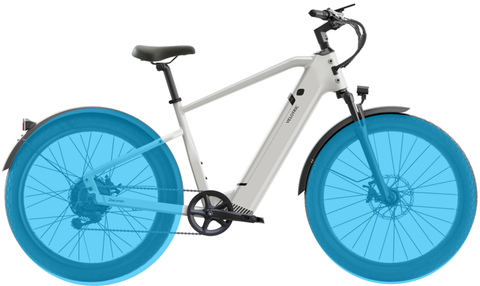
Components of the Wheelset System
- Wheels (Rims and Hubs):The wheel's rim provides the structure, while the hub sits at the center and includes the axle and bearings. Spokes connect the hub to the rim. The design and materials of rims and hubs influence the wheel's strength, weight, and aerodynamics.
- Tires:Tires are the bike's point of contact with the ground. Their tread pattern, width, and rubber compound can significantly affect traction, speed, and shock absorption. Tires for e-bikes are often reinforced to handle additional weight and speed.
- Tubes:Most traditional bike tires require inner tubes, which are inflatable rubber tubes that fit inside the tire to hold air. Tubeless systems, where the tire seals directly to the rim, are becoming more popular for their ability to run at lower pressures and their reduced risk of punctures.
Wheel Sizes
Different wheel sizes offer unique benefits and are tailored for specific bike types and riding styles, like:
- 20-inch:Commonly found on folding E-bikes, 20-inch wheels are great for compact storage and portability. They allow for easy maneuvering in tight urban spaces and quick acceleration, making them ideal for city commuting.
- 24-inch:Often used on junior or smaller frame E-bikes, 24-inch wheels offer a good balance between control and efficiency. They are large enough to handle bumps and small obstacles smoothly while still maintaining a manageable size for younger riders or those of shorter stature.
- 26-inch:Still a prevalent size in E-bikes, 26-inch wheels are known for their quick acceleration and maneuverability. They're versatile enough for both urban environments and moderate off-road use, making them a flexible option for many riders.
- 5-inch (650B):This size offers a middle ground between the agility of 26-inch wheels and the rolling efficiency of 29-inch wheels. It is preferred in mountain E-bikes for its superior traction and control on rough terrain without significant sacrifices in acceleration.
- 29-inch:Also known as 29ers, these wheels are favored for their excellent rolling efficiency over obstacles. They are commonly used on mountain E-bikes and for off-road purposes. The larger diameter provides increased stability and speed over long distances but may feel less nimble on tight trails.
- 700C:The standard size for road E-bikes, similar in diameter to 29-inch wheels but typically narrower. These wheels are optimized for speed and efficiency on paved surfaces, making them ideal for road cycling.
E-bike Wheel Size on Performance
- Handling and Comfort:Larger wheels generally provide smoother rides over bumps and are more stable at higher speeds. Smaller wheels can offer quicker handling and acceleration. The choice of wheel size can also affect the bike's fit for different riders.
- Efficiency:The wheelset's weight impacts the bike's overall efficiency, as lighter wheels require less energy to accelerate. However, the durability and strength of the wheels must also be considered, especially for e-bikes, which are typically heavier and can reach higher speeds than traditional bikes.
- Compatibility:It's important to note that not all wheel sizes are compatible with every bike frame and fork, due to clearance issues or design specifications. When selecting a wheelset, one must ensure it fits the intended bike model and suits the rider's needs.
How to Choose the Right E-bike Wheel Size
You can refer to the following rules:
- Small Wheel Size (20" - 24"):Best for urban commuting and folding e-bikes. These sizes offer quicker acceleration and easier maneuverability in tight spaces. Ideal for riders looking for convenience and agility over rough ride comfort and high speed.
- Medium Wheel Size (26"):A versatile size that balances maneuverability with stability. It's a common size for traditional bikes and offers a middle ground in performance characteristics.
- Large Wheel Size (27.5" - 29"):Preferred for mountain and performance-oriented e-bikes. Larger wheels roll over obstacles more easily and maintain momentum better, offering improved stability and efficiency at higher speeds.
Ebike Tire Size
Tire size is typically represented by two numbers, indicating the diameter and width of the tire, respectively. These measurements are usually given in inches or millimeters, depending on the tire's design and the manufacturer's preference. Here's how size plays into the performance and use of ebike tires:
Diameter
In fact, the diameter of an e-bike tire generally means wheel size. For detailed information, you can check the wheel size part.
Width
The width is the second number in the tire size (e.g., 2.1", 2.25", or 28mm). It influences the tire's grip, comfort, and resistance:
|
Width |
Range |
Implications for Performance and Use |
|
Narrow Width |
25mm to 28mm |
Provides less rolling resistance on smooth surfaces, making them faster and more efficient for road use. Best suited for road eBikes. |
|
Wide Width |
2.0" to 2.6" |
Offers more cushioning, better grip, and stability, particularly beneficial for off-road use. Handles the extra weight and speed of eBikes well.Ideal for mountain eBikes and rugged terrains. |
How to Understand Tire Size Markings
When it comes to understanding the size markings on bicycle tires, it's essential to know that these measurements are found on the tire's sidewall. However, deciphering these values can be somewhat confusing due to the different measurement systems used, namely, the Metric (ETRTO), Imperial (Inch), and French systems. Read on to learn how to interpret the 3 tire size markings:
- Metric System (ETRTO)
ETRTO stands for European Tyre and Rim Technical Organisation. This metric system is considered the standard for tire size markings. It measures the internal diameter of the tire rim and the tire width in millimeters. This system is universally used in tire sizes available on the market today. For instance, a tire marked as "23-622" indicates a tire width of 23 mm and an internal rim diameter of 622 mm.
- Imperial System (Inch)
The imperial system uses inches to represent the size of the tire, focusing on the external diameter and width of the tire. This measurement system is particularly representative of mountain bike tires, with common sizes being 26", 27.5", and 29". These values give a straightforward understanding of the tire's size, appealing especially to those familiar with the imperial measurement system.
- French System
The French system, despite being metric in its units, differs from the ETRTO system by measuring the external diameter of the tire. A typical size under this system is the 700C tire, which is a common size for road bikes. The "C" does not stand for a specific measurement but is part of a historical French sizing system that indicated the outer diameter of the tire.
Understanding these different systems can significantly help you choose the correct tire for your bicycle, ensuring compatibility and optimal performance. Each system has its unique way of representing tire sizes, catering to various preferences and standards across the globe.
In summary, the wheelset system is critical to an e-bike's performance, influencing everything from speed and handling to comfort and efficiency. Choosing the right wheel size and type is essential for optimizing the riding experience, whether for urban commuting, off-road adventure, or anything in between.
Brake System
The brake system is a critical safety feature of electric assist bicycles, allowing riders to control speed and stop effectively under various conditions. E-bikes typically come equipped with front and rear brakes, which can be categorized into rim brakes and disc brakes. Each type has its specific advantages, and the choice between them often depends on the rider's preferences, riding conditions, and the e-bike's design.
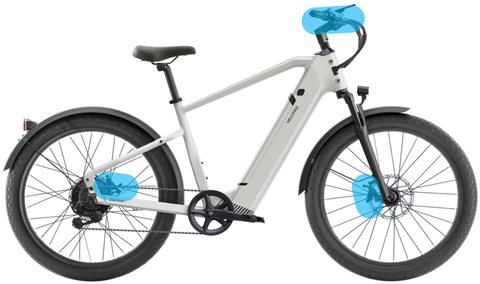
Brake System Components
- Front and Rear Brakes:E-bikes are equipped with both front and rear brakes, which can be either rim brakes or disc brakes, depending on the bike's design and intended use.
- Left and Right Brake Levers:Positioned on the handlebars, these levers control the front and rear brakes, respectively. The standard setup in most regions is for the right lever to control the rear brake and the left lever to the front brake, though this can vary.
Rim Brakes
Rim brakes apply friction directly to the wheel's rim to slow down the bike. There are two main types of rim brakes:
- Caliper Brakes:Commonly found on road bikes, caliper brakes mount to a single point above the wheel and "squeeze" the rim between two brake pads. They are lightweight and simple but can be less effective in wet or muddy conditions.
- V-Brakes (or Linear Pull Brakes):More common on mountain bikes and some urban bikes, V-brakes offer more stopping power than caliper brakes and are easier to maintain. However, they can still suffer from decreased performance in adverse weather.
Disc Brakes
Disc brakes apply braking force to a rotor attached to the wheel hub, offering superior performance, especially in wet and muddy conditions. They are divided into two types:
- Mechanical Disc Brakes:These operate via a cable that activates the caliper, pushing the brake pads against the rotor to create friction. Mechanical disc brakes are simpler and easier to maintain than hydraulic brakes, making them a cost-effective option that still offers better performance than most rim brakes.
- Hydraulic Disc Brakes:Hydraulic brakes use fluid within a sealed system to move the brake pads against the rotor. This type provides more powerful and progressive braking with minimal effort on the brake lever. Hydraulic disc brakes offer the best stopping power and control, making them ideal for high-speed e-biking and challenging terrains.
Rotors
In eBikes, rotors are discs mounted on the wheel hubs. They are part of the disc brake system. When the brakes are activated, the brake pads within the caliper press against the rotor, slowing down the wheel's rotation through friction.
Rotor Attachment Styles
- Center Lock:A system that secures the rotor to the hub with a central locking ring, facilitating easier rotor changes and offering a cleaner look.
- 6 Bolt:The more traditional method, using six screws to attach the rotor to the hub, compatible with a wide range of hubs and wheels.
How to Choose the Ebike Rotor Size
The size of the disc brake rotor influences the braking force and heat dissipation:
- 140mm:Typically used on road bikes for light braking needs.
- 160mm:A versatile size suitable for both road and mountain bikes, offering a balance of stopping power and weight.
- 180mm:Provides increased stopping power for aggressive road riding or mountain biking.
- 203mm:The choice for heavy-duty mountain biking, offering the maximum stopping power for steep descents and large riders.

When selecting the ideal brake system for your electric assist bicycle, consider your riding style, typical terrain, and personal preferences.
For riders prioritizing lightweight efficiency and primarily navigating urban or flat terrains, rim brakes might offer a suitable balance of performance and simplicity. On the other hand, if you frequently ride in wet, muddy conditions, or engage in aggressive mountain biking, disc brakes-particularly hydraulic disc brakes-will provide superior stopping power and control.
The size of the rotor should also match your riding demands: smaller rotors for lighter, less aggressive riding and larger rotors for more demanding, high-speed adventures.
Ultimately, the choice of brake system should enhance your riding experience, offering a blend of safety, control, and confidence across all conditions.
Control System
The control system of an electric assist bicycle, crucial for maneuvering and steering, is a pivotal element that enhances the riding geometry, comfort, and overall experience. Mounted on the frame and the fork, this system is essentially an extension of the frame's functionality, incorporating components like the handlebars, stem, saddle, and seat post.

Handlebars
Flat Bars
Standard on mountain bikes and urban e-bikes, these bars ensure a stable, upright position, offering excellent control on technical terrains and ease of maneuvering in traffic. Paired with short stems, wide flat bars on mountain bikes provide stable handling, while the short stem enhances steering agility, essential for navigating challenging off-road terrains.
- Riser Bars:Characterized by a noticeable rise from the center towards the ends, offering a more upright and comfortable riding position.
- Bar Width:The distance between the ends of the handlebar, with wider bars offering greater control on technical trails.
- Flat Bar Design:Ensures that the section from the center to the ends is on the same plane, facilitating consistent handling.
- Clamp Sizes:Vary based on the intended use, with 25.4mm typically used on city bikes, 31.8mm on standard mountain bikes, and 35mm on heavy-duty off-road bikes. The ends of the bars are usually standardized at 22.2mm to maintain compatibility with grips and controls.
Drop Bars
Integral to road cycling, drop bars on road bikes allow for multiple hand positions to adapt to various riding scenarios like flat roads, climbs, descents, and sprints. This versatility enables riders to switch between aerodynamic postures and more relaxed positions, optimizing for speed or comfort as needed.
- Back Sweep (Back Warp):This angle influences wrist comfort and reach, optimizing the rider's leverage and control.
- Bar Width:Measured from the center of one end to the other, affecting the bike's aerodynamics and maneuverability.
- Bar Reach:The distance the bars extend forward, which impacts accessibility to brake levers and shifters.
- Bar Drop:The vertical distance from the bar's highest to its lowest point, allowing riders to lower their center of gravity for speed or climb efficiently.
Swept-Back Bars
Favored for their comfort and ease of use, swept-back bars are commonly found on cruiser and comfort bikes, as well as some urban e-bikes. These handlebars curve back towards the rider, promoting a more relaxed and ergonomic riding posture, reducing strain on the arms and back.
- Sweep Angle: The degree to which the bars curve back towards the rider, which can significantly affect comfort and control.
- Bar Width: Typically narrower than those found on mountain bikes, enhancing comfort without compromising on control.
- Ergonomics: The design often includes a gentle rise, contributing to an even more upright riding position ideal for leisurely rides and long distances.
- Compatibility: Often compatible with various grips and controls, these bars accommodate a relaxed grip, suitable for casual and commuter cycling.
Stem
The stem connects the handlebars to the fork's steerer tube, affecting the bike's reach and the rider's position. Stem involves the length (from the front bolt to the steerer tube center) and angle adjustments, which cater to different riding dynamics, ranging from relaxed to aggressive. The clamp sizes for the steerer tube and handlebars (e.g., 1-1/8", 1-1/4" for the steerer tube and 31.8mm, 35mm for the handlebars) need to match the respective components, ensuring a secure and proper fit.
Saddle
The saddle, or seat, is one of the most personal and critical components for rider comfort. Its shape, width, and padding should match the rider's anatomy and riding style:
- Racing Saddles:Characterized by their streamlined, narrow design and minimal padding, racing saddles are engineered for speed and efficiency. They facilitate a forward-leaning position, reducing wind resistance and maximizing power output from the legs. This type of saddle is ideal for riders engaging in competitive racing or those who prefer a more aggressive riding style. The reduced width minimizes thigh rubbing, allowing for greater freedom of leg movement.
- Comfort Saddles:In contrast, comfort saddles are broader and equipped with ample cushioning to support a more relaxed, upright riding position. This design is particularly beneficial for leisurely rides, commuting, or touring, where comfort over long distances takes precedence over speed. The additional width better distributes the rider's weight, reducing pressure on the sit bones and delicate soft tissues.
Proper saddle selection and adjustment are vital for avoiding discomfort and potential injuries over long distances.
Seat Post & Clamp
Seat Post
- Offset and Positioning:The offset, or setback, refers to the distance between the seat post's center and the clamp that holds the saddle, typically ranging from 0 to 25mm. This feature is essential for adjusting the rider's fore-aft position on the bike, directly influencing riding posture and pedaling efficiency. An optimal setback is critical for achieving a balanced ride, ensuring the rider's knees are properly aligned over the pedals, which can enhance power output and reduce the risk of knee strain.
- Length:The length of the seat post determines how high the saddle can be set, affecting leg extension and pedaling dynamics. Common lengths vary from 300mm to 400mm, catering to different rider heights and bike sizes.
- Diameter: The outer diameter of the seat post must match the internal diameter of the seat tube on the bike frame. Standard sizes include 27.2mm, 28.6mm, and 31.6mm, though variations exist to fit different bikes. The diameter not only ensures a snug fit but also affects the seat post's structural integrity and the bike's overall aesthetic. As bike designs evolve, we're seeing a trend toward non-circular cross-sections, such as aerodynamic tear-drop shapes, which can offer performance benefits and unique looks.
A special mention goes to suspension seat posts that are designed to add comfort to the ride by absorbing shocks and vibrations from uneven surfaces. Ideal for both urban and off-road environments, suspension seat posts use internal springs, elastomers, or hydraulics to cushion impacts and smooth out the ride. They are particularly beneficial for riders who traverse rough terrain or cobblestone streets where the reduction of shock can significantly increase comfort and reduce fatigue.
Seat Post Clamp
- Function:The seat post clamp secures the seat post within the bike frame, allowing for height adjustments while ensuring the post stays in place during rides. This component is crucial for maintaining the desired saddle height and position, a fundamental aspect of rider comfort and efficiency.
- Types:Seat post clamps come in two main varieties-bolted and quick-release. Bolted clamps provide a secure hold, requiring tools for adjustments, making them a good choice for riders who don't frequently adjust saddle height. Quick-release clamps offer the convenience of tool-free adjustment, ideal for cyclists who prefer the flexibility of easily changing seat height between or during rides.
- Saddle Rail Clamp:Atop the seat post, the saddle rail clamp grabs the saddle's rails, allowing for precise adjustments of the saddle's tilt and fore-aft position. This adjustability is key to fine-tuning the saddle's orientation for maximum comfort and effective pedaling, impacting the rider's comfort during long rides or intense efforts.
Whether you're navigating city streets, tackling mountain trails, or cruising on open roads, the right seat post setup can significantly enhance your cycling experience, offering a blend of adjustability, performance, and personalized fit.
At the end of this section, you must have a better grip on the control system's configuration directly impacting the bike's handling, comfort, and efficiency. A well-adjusted control system tailored to the rider's body and preferences can enhance performance, reduce fatigue, and prevent injuries, making the cycling experience more enjoyable and sustainable, especially on an electric assist bicycle where rides tend to be longer and cover more varied terrains. Proper bike fitting is essential to optimize these components for individual riders, ensuring the best possible interaction with the bike.
Tri-Electric System
The Tri-Electric System of an electric assist bicycle consists of three core components: the battery, motor, and controller. This system is the heart of an e-bike, driving its performance, range, and overall user experience. Each component plays a distinct role, and together, they determine the bike's capability, efficiency, and usability.
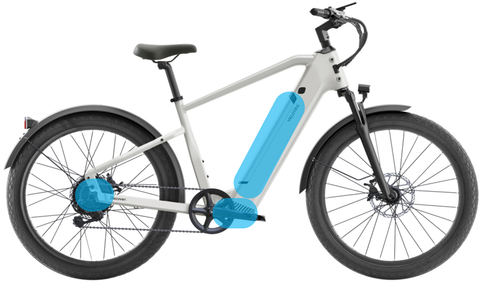
Battery
The battery is the e-bike's power source, storing electrical energy that drives the motor. Factors influencing a battery's performance include:
- Capacity:The battery's capacity, typically expressed in watt-hours (Wh), is a crucial determinant of the e-bike's range. It dictates how far the bike can travel on a single charge. Generally, a higher capacity translates to a longer range but at the cost of increased weight and expense. For instance, a battery with a 500Wh capacity might power an e-bike for up to 70 miles, depending on factors like terrain and rider weight.
- Type:Lithium-ion batteries dominate the market, favored for their optimal energy density, which packs a larger amount of power into a lighter unit, and their prolonged lifespan, outperforming alternatives like lead-acid batteries.
- Placement: Where the battery sits on the bike influences not just its look but its handling too. Batteries integrated into the frame offer better weight distribution and a sleeker appearance, while those mounted on the rear rack might be easier to remove but can shift the bike's center of gravity.
- Recharge Time:The duration needed to fully charge the battery can vary, typically ranging from 3 to 8 hours. This factor is crucial for riders who rely on their e-bike for daily commuting.
Motor
The motor converts electrical energy from the battery into mechanical energy, assisting the rider's pedaling effort. Motors vary in their placement on the bike (front hub, rear hub, or mid-drive), each offering distinct advantages:
- Front Hub Motor: Provides propulsion at the front, helping pull the bike forward. It's simple and typically less expensive but can affect steering and traction.
- Rear Hub Motor:Pushes the bike from the rear, offering better traction and a more natural riding experience. It's suitable for commuting and general use.
- Mid-Drive Motor:Located at the bike's crank, this type offers superior efficiency and balance by directly driving the bike's chain. It's ideal for hills and off-road conditions, providing a more natural pedaling feel but at a higher price tag.
The motor's power, measured in watts, influences the e-bike's speed and ability to climb hills. Legal limits on motor power and assisted speed vary by region.
Controller
The controller is the brain of the e-bike's tri-electric system, regulating the power flow from the battery to the motor based on the rider's input (e.g., through a pedal-assist system or throttle). It affects how the bike responds to rider commands, offering a range of assistance levels and sometimes regenerative braking, which can help recharge the battery during deceleration. Key aspects include:
- User Interface:Many controllers come with displays showing speed, battery level, and selected assistance level, enhancing the rider's control over the e-bike's performance.
- Customization:Some systems allow riders to customize settings, tailoring the bike's response to their preferences and riding conditions.
Together, these components form a sophisticated system that defines the electric assist bicycle's functionality. The integration and quality of the tri-electric system components significantly affect the e-bike's appeal, performance, and versatility, making them key factors in the selection of an e-bike.
The Bottom Line
Having fully understood the details and benefits of what makes an e-bike, you're probably eager to experience the convenience, speed, and eco-friendliness they offer. VELOTRIC stands ready to match your enthusiasm with a variety of options that cater to different needs and preferences.
Whether you're looking for a boost on your daily commute, an aid on challenging trails, or simply a more sustainable way to travel, VELOTRIC always has something special for you. Visit VELOTRIC's offerings today and discover how an e-bike can transform your life.







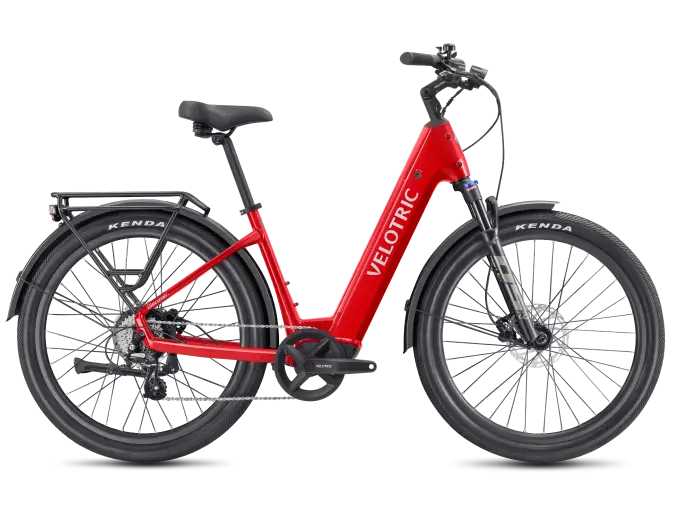












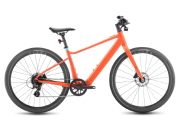
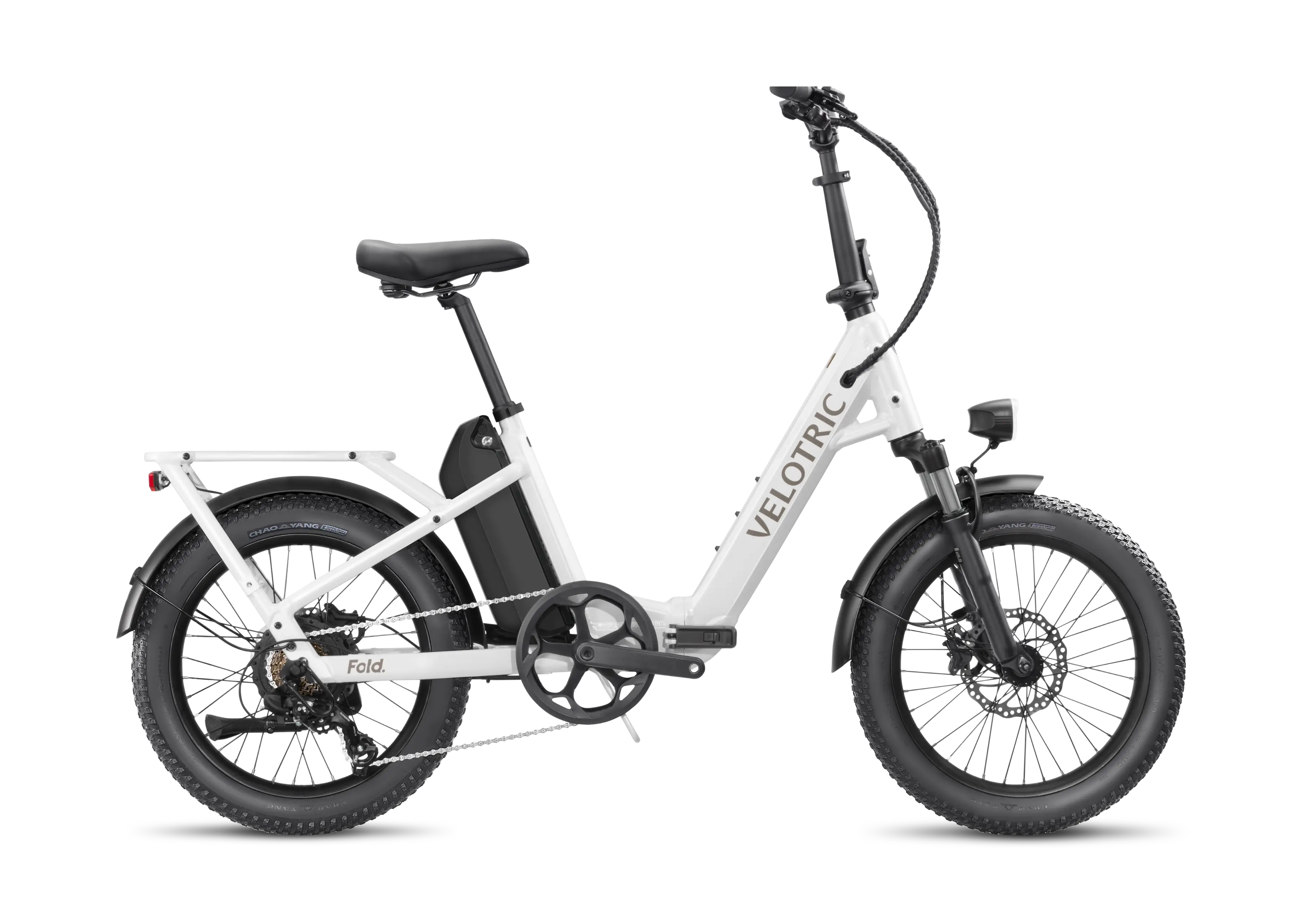
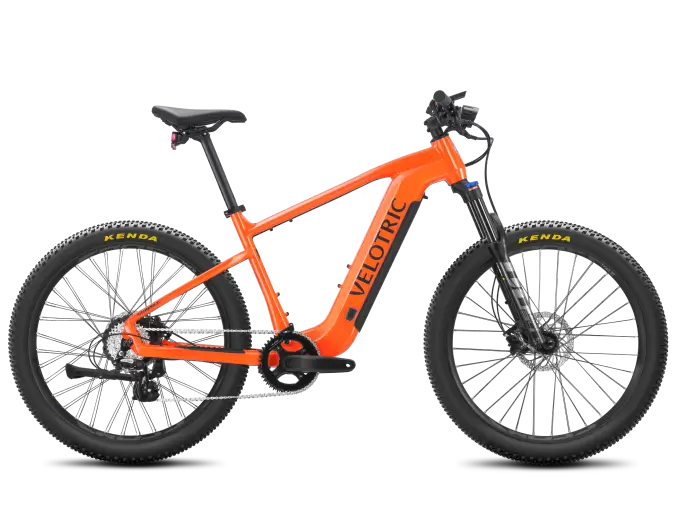
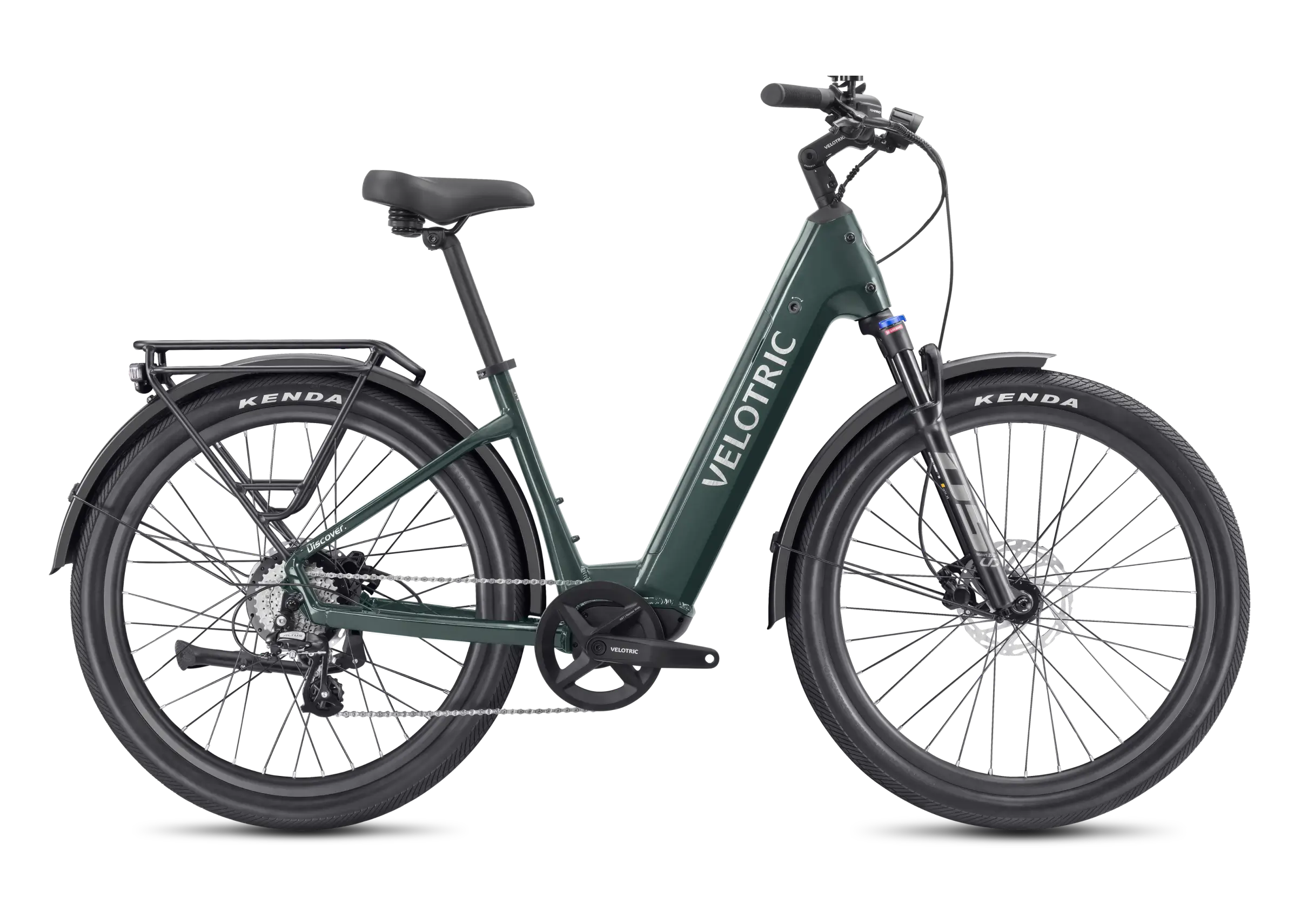


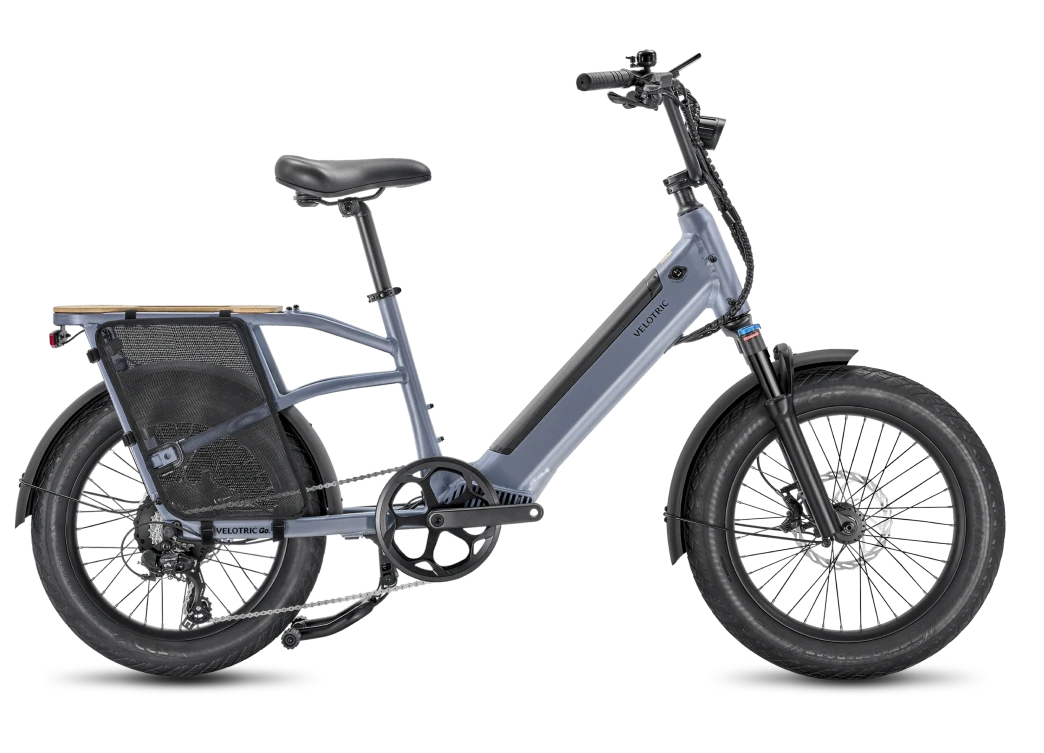




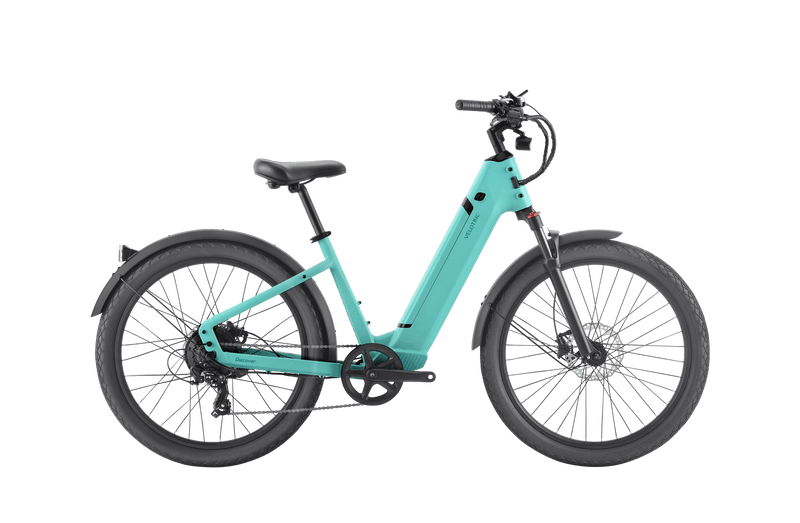
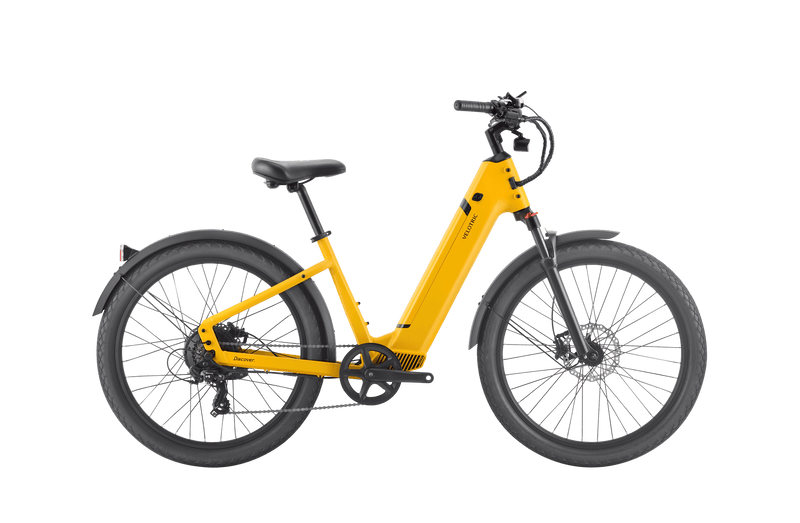
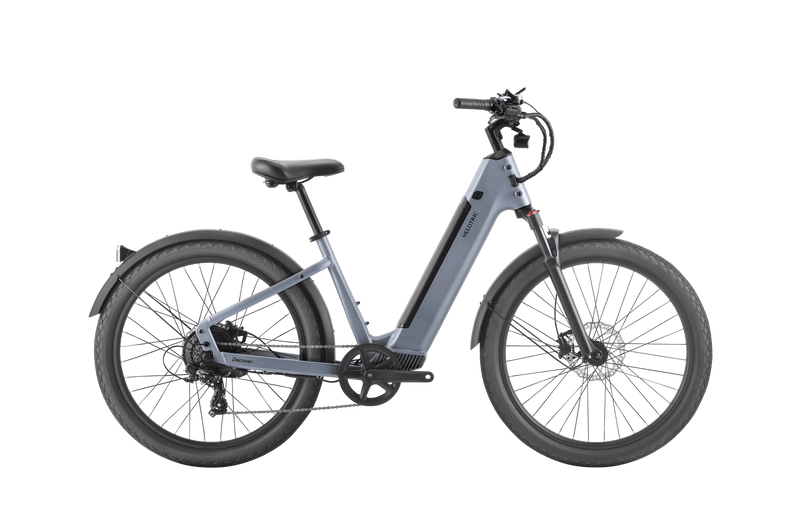
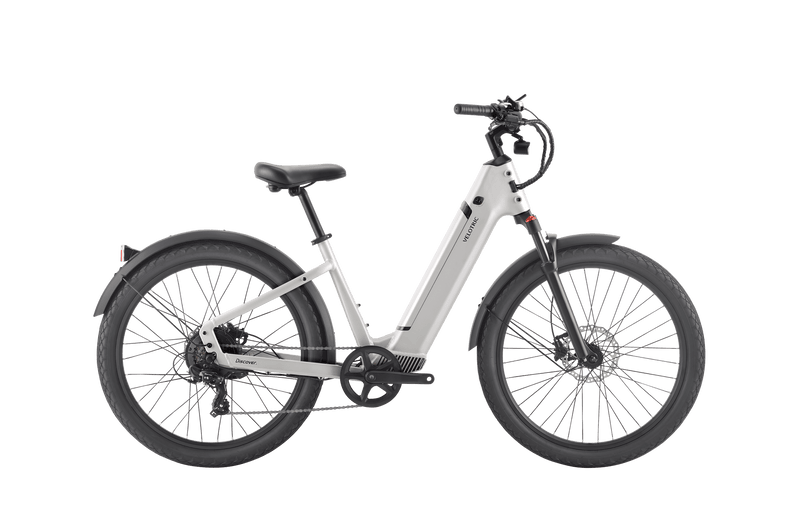
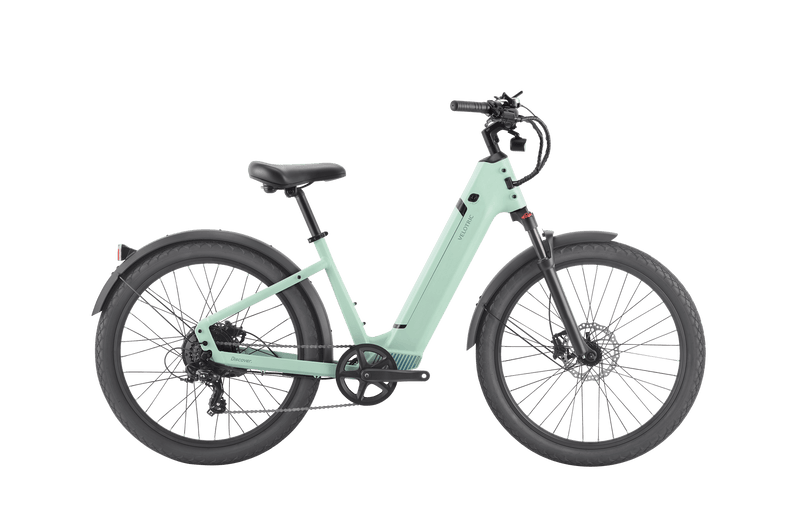
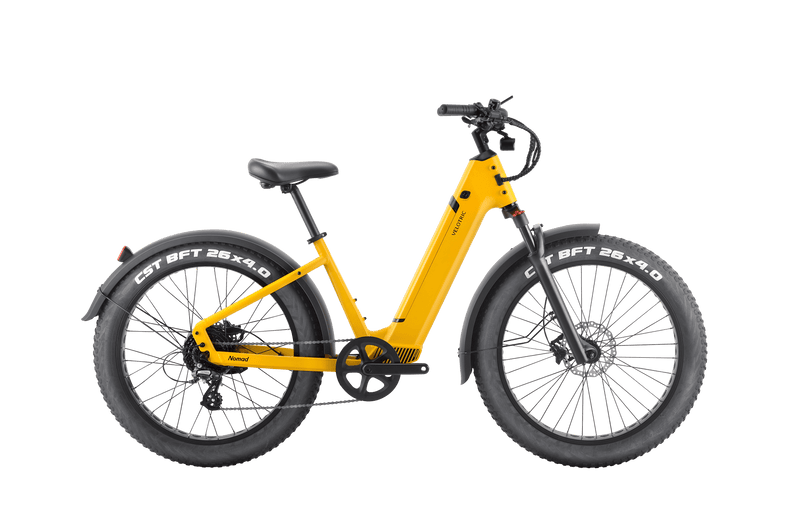
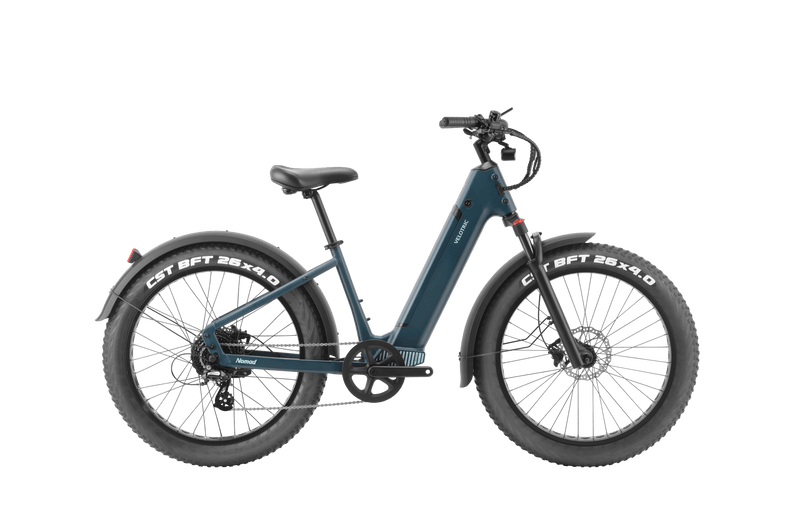
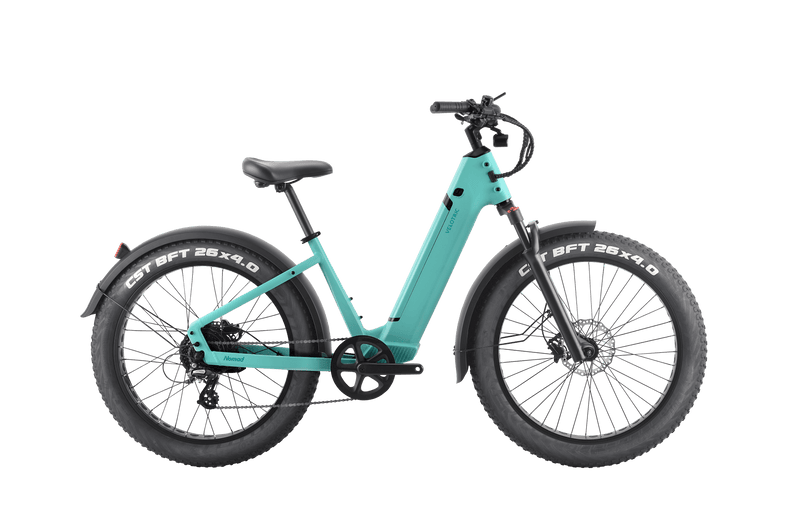
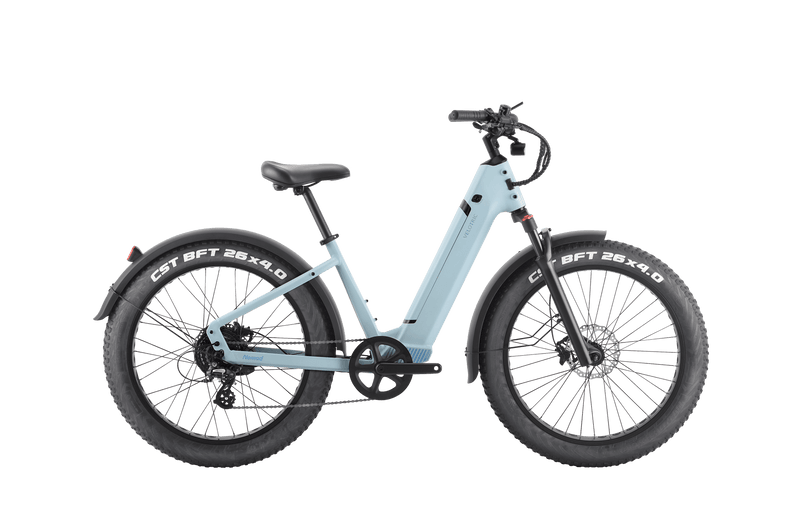
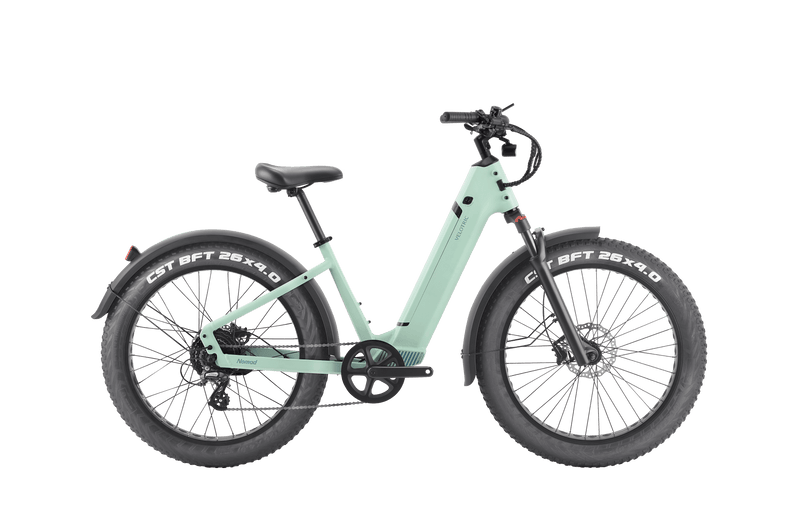
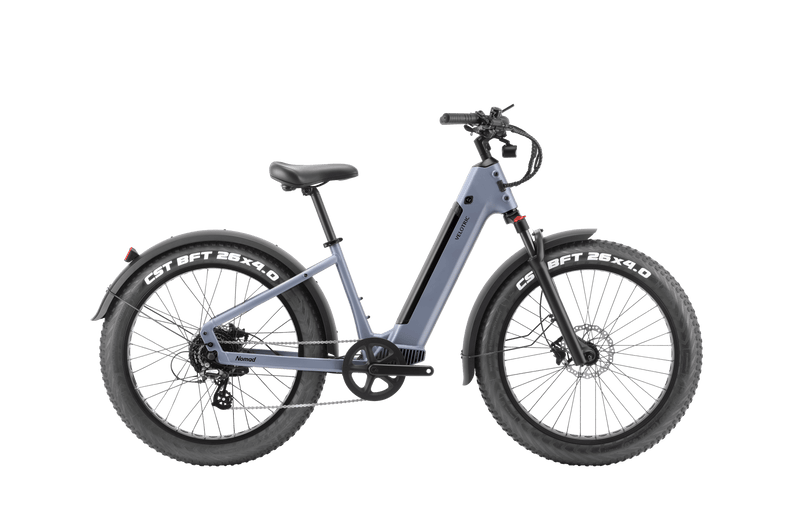
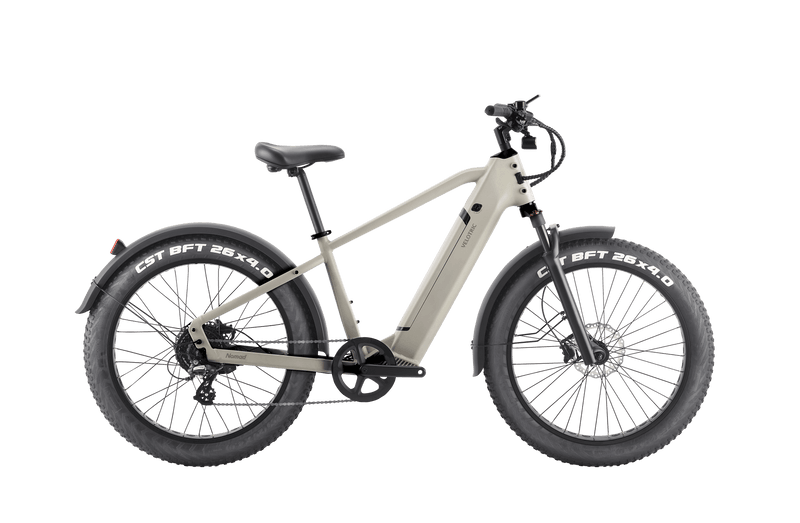
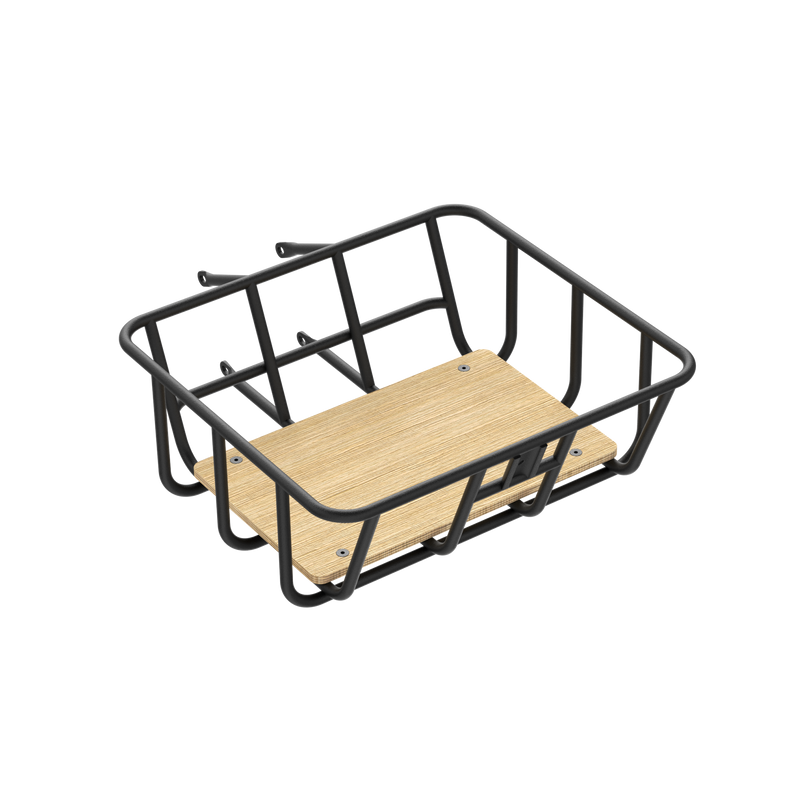
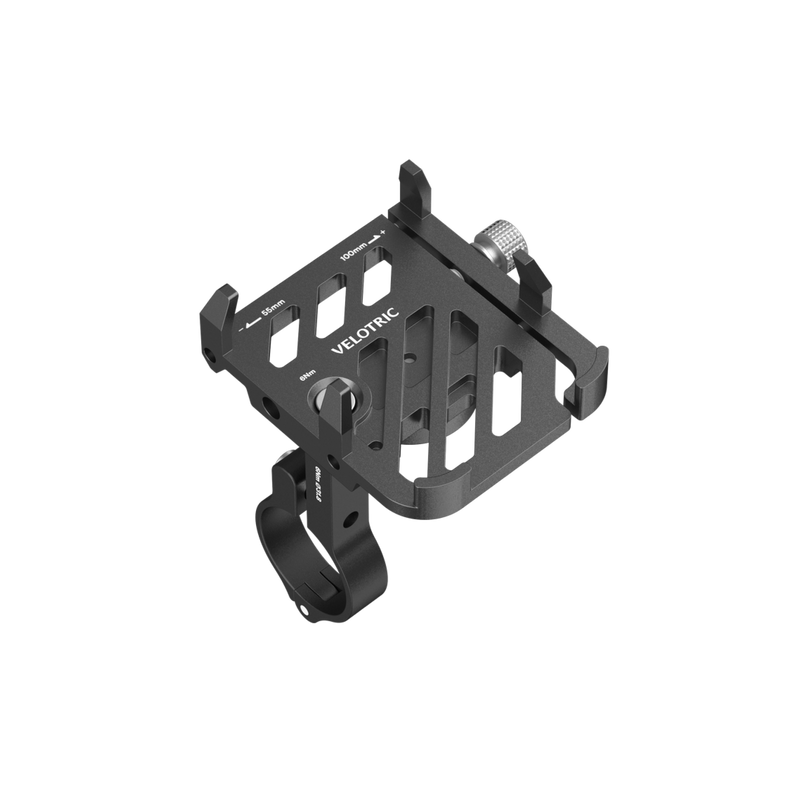
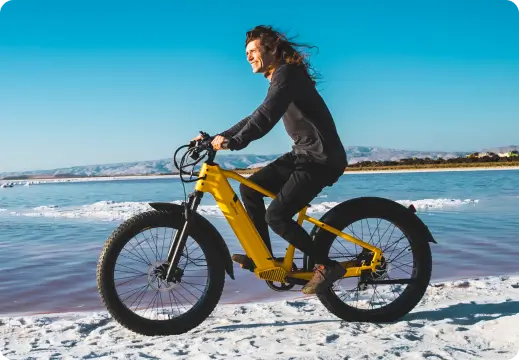

Leave a comment